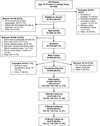Computer and therapist based brief interventions among cannabis-using adolescents presenting to primary care: one year outcomes
- PMID: 23711998
- PMCID: PMC3770780
- DOI: 10.1016/j.drugalcdep.2013.04.020
Computer and therapist based brief interventions among cannabis-using adolescents presenting to primary care: one year outcomes
Abstract
Aims: This paper describes outcomes from a randomized controlled trial examining the efficacy of brief interventions delivered by a computer (CBI) or therapist (TBI) among adolescents in urban primary care clinics.
Methods: Patients (ages 12-18) self-administered a computer survey. Adolescents reporting past year cannabis use completed a baseline survey and were randomized to control, CBI or TBI, with primary (cannabis use, cannabis related consequences - CC) and secondary outcomes [alcohol use, other drug use (illicit and non-medical prescription drugs), and driving under the influence of cannabis (DUI)] assessed at 3, 6, and 12 months.
Results: 1416 adolescents were surveyed; 328 reported past year cannabis use and were randomized. Comparisons of the CBI relative to control showed that at 3 months the group by time interaction (G × T) was significant for other drug use and CC, but not for cannabis use, alcohol use, or DUI; at 6 months, the G × T interaction was significant for other drug use but not for cannabis use, alcohol use, or CC. For analyses comparing the TBI to control, at 3 months the G×T interaction was significant for DUI, but not significant for cannabis use, alcohol use, or CC; at 6 months, the G×T interaction was not significant for any variable. No significant intervention effects were observed at 12 months.
Conclusion: Among adolescent cannabis users presenting to primary care, a CBI decreased cannabis related problems and other drug use and a TBI decreased cannabis DUI in the short-term. Additional boosters may be necessary to enhance these reductions over time.
Trial registration: ClinicalTrials.gov NCT01329315.
Keywords: Adolescent; Brief intervention; Cannabis; Computer; Primary care.
Copyright © 2013 Elsevier Ireland Ltd. All rights reserved.
Conflict of interest statement
The authors do not have any conflicts of interest to declare.
References
-
- American Medical Association. Guidelines for Adolescent Preventive Services (GAPS) Chicago: American Medical Association; 1997. - PubMed
-
- Baer JS, Peterson PL. Adolescents and young adults. In: Miller WR, Rollnick S, editors. Motivational Interviewing: Preparing People for Change. 2nd. New York: The Guilford Press; 2002. pp. 320–332.
-
- Brener ND, Billy JO, Grady WR. Assessment of factors affecting the validity of self-reported health-risk behavior among adolescents: evidence from the scientific literature. J. Adolesc. Health. 2003;33:436–457. - PubMed
-
- Brook DW, Brook JS, Zhang C, Cohen P, Whiteman M. Drug use and the risk of major depressive disorder, alcohol dependence, and substance use disorders. Arch. Gen. Psychiatry. 2002;59:1039–1044. - PubMed
Publication types
MeSH terms
Associated data
Grants and funding
LinkOut - more resources
Full Text Sources
Other Literature Sources
Medical
Miscellaneous


